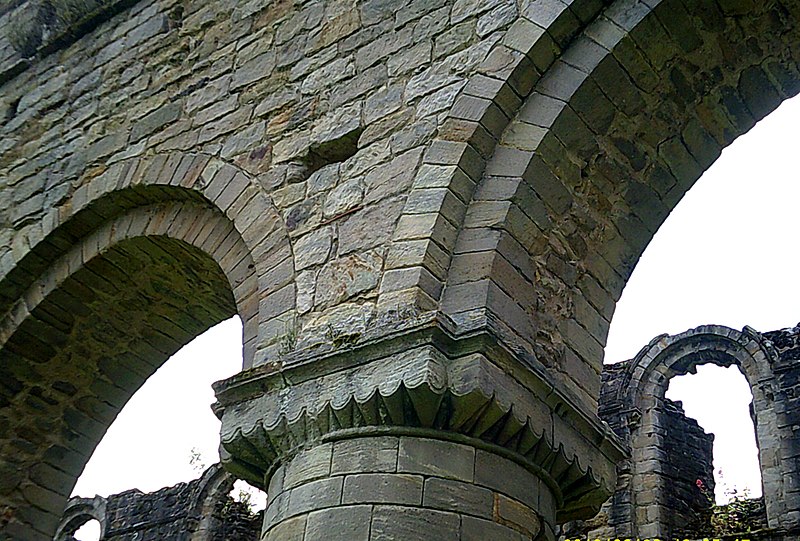Putlog holes

|
| At the Buildwas Abbey in Shropshire, the capital of a column in the north nave shows scalloped decoration. Directly above the column a putlog hole - used for supporting scaffolding during the building - remains. |
Contents |
[edit] Introduction
Putlog holes (also referred to as putlock holes or putholes) are small gaps or recesses incorporated into the construction of a stone or brick wall. Their purpose is to support the short horizontal beams or round poles known as putlogs (or putlocks).
This configuration uses the wall of the structure - along with the putlogs in the putlog holes - to create a type of building platform known as a putlog scaffold. Putlog holes sometimes pass through the entire wall to support the construction of scaffolding on both sides of the wall.
[edit] History
It is believed that this form of scaffolding - originally referred to as socket scaffolding - goes back to early Roman Christian times - perhaps as far back as the fourth century AD. Evidence can be seen in paintings such as the one found on the Hypogeum of Trebius Justus on the via Latina. Within the tympanum of the vault of the tomb is an illustration of workers constructing a brick building using the putlog scaffolding configuration.
Introduced in the 17th century, the terms putlog and putlock have origins in an old masonry phrase used to describe the hole in the wall where workers “put the log” to build the scaffolding during construction. This technique was frequently used to build castles, aqueducts. fortresses and other large structures throughout Europe. The putlog holes - which did not compromise the strength of the walls - remain in many of these buildings.
[edit] Modern putlog scaffolding
In modern construction, putlog scaffolding is sometimes referred to as bricklayer’s scaffolding or single scaffolding (since it is made up of only a single row of standards joined together by ledgers fixed with right-angle couplers). This configuration supports the transverse transoms (or putlogs) which are built into the brickwork bed joints as work proceeds. This type of scaffold can only be used for new works in brick or block.
The holes and logs are sometimes left in the wall after construction is complete. Putlogs that are left behind are sometimes sawn off so they are flush with the wall.
Exterior putlog holes are usually filled in to prevent water penetration. Internal putlog holes are sometimes left unfinished and open.
[edit] Related articles on Designing Buildings Wiki
IHBC NewsBlog
Old Sarum fire in listed (& disputed) WW1 Hangar - Wiltshire Council has sought legal advice after fire engulfed a listed First World War hangar that was embroiled in a lengthy planning dispute.
UK Antarctic Heritage Trust launches ‘Virtual Visit’ website area
The Trust calls on people to 'Immerse yourself in our heritage – Making Antarctica Accessible'
Southend Council pledge to force Kursaal owners to maintain building
The Council has pledged to use ‘every tool in the toolbox’ if urgent repairs are not carried out.
HE’s Research Magazine publishes a major study of the heritage of England’s suburbs
The article traces the long evolution of an internal programme to research 200 years of suburban growth
IHBC Context 183 Wellbeing and Heritage published
The issue explores issues at the intersection of heritage and wellbeing.
SAVE celebrates 50 years of campaigning 1975-2025
SAVE Britain’s Heritage has announced events across the country to celebrate bringing new life to remarkable buildings.
IHBC Annual School 2025 - Shrewsbury 12-14 June
Themed Heritage in Context – Value: Plan: Change, join in-person or online.
200th Anniversary Celebration of the Modern Railway Planned
The Stockton & Darlington Railway opened on September 27, 1825.
Competence Framework Launched for Sustainability in the Built Environment
The Construction Industry Council (CIC) and the Edge have jointly published the framework.
Historic England Launches Wellbeing Strategy for Heritage
Whether through visiting, volunteering, learning or creative practice, engaging with heritage can strengthen confidence, resilience, hope and social connections.













